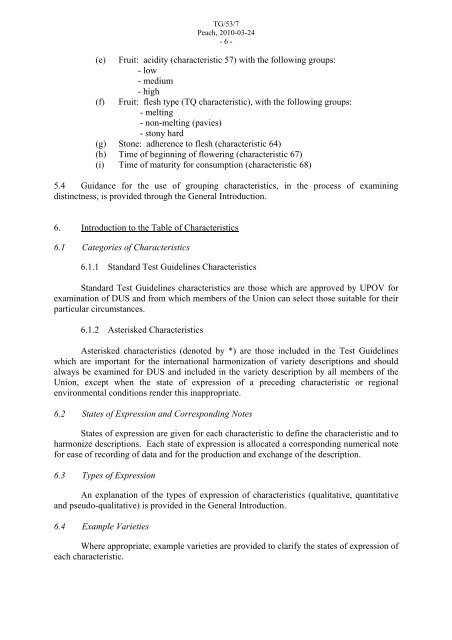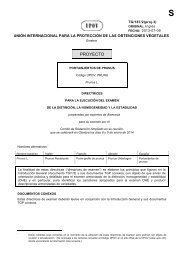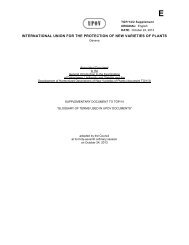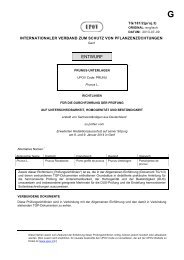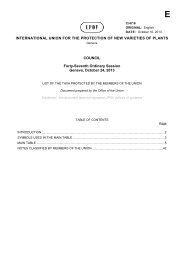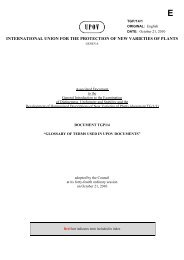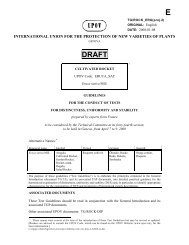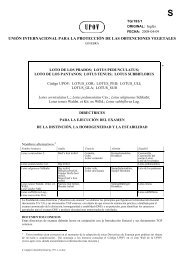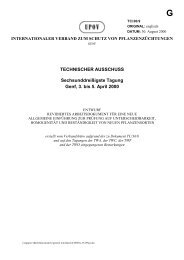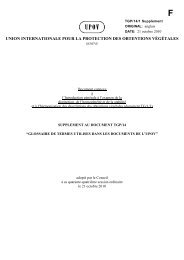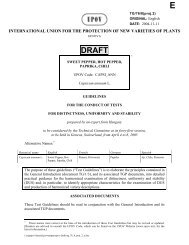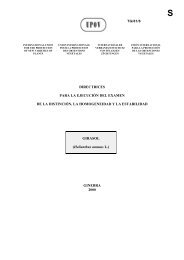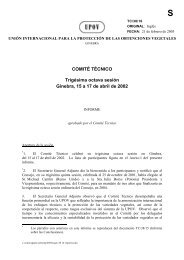Peach, Nectarine - International Union for the Protection of New ...
Peach, Nectarine - International Union for the Protection of New ...
Peach, Nectarine - International Union for the Protection of New ...
Create successful ePaper yourself
Turn your PDF publications into a flip-book with our unique Google optimized e-Paper software.
TG/53/7<br />
<strong>Peach</strong>, 2010-03-24<br />
- 6 -<br />
(e) Fruit: acidity (characteristic 57) with <strong>the</strong> following groups:<br />
- low<br />
- medium<br />
- high<br />
(f) Fruit: flesh type (TQ characteristic), with <strong>the</strong> following groups:<br />
- melting<br />
- non-melting (pavies)<br />
- stony hard<br />
(g) Stone: adherence to flesh (characteristic 64)<br />
(h) Time <strong>of</strong> beginning <strong>of</strong> flowering (characteristic 67)<br />
(i) Time <strong>of</strong> maturity <strong>for</strong> consumption (characteristic 68)<br />
5.4 Guidance <strong>for</strong> <strong>the</strong> use <strong>of</strong> grouping characteristics, in <strong>the</strong> process <strong>of</strong> examining<br />
distinctness, is provided through <strong>the</strong> General Introduction.<br />
6. Introduction to <strong>the</strong> Table <strong>of</strong> Characteristics<br />
6.1 Categories <strong>of</strong> Characteristics<br />
6.1.1 Standard Test Guidelines Characteristics<br />
Standard Test Guidelines characteristics are those which are approved by UPOV <strong>for</strong><br />
examination <strong>of</strong> DUS and from which members <strong>of</strong> <strong>the</strong> <strong>Union</strong> can select those suitable <strong>for</strong> <strong>the</strong>ir<br />
particular circumstances.<br />
6.1.2 Asterisked Characteristics<br />
Asterisked characteristics (denoted by *) are those included in <strong>the</strong> Test Guidelines<br />
which are important <strong>for</strong> <strong>the</strong> international harmonization <strong>of</strong> variety descriptions and should<br />
always be examined <strong>for</strong> DUS and included in <strong>the</strong> variety description by all members <strong>of</strong> <strong>the</strong><br />
<strong>Union</strong>, except when <strong>the</strong> state <strong>of</strong> expression <strong>of</strong> a preceding characteristic or regional<br />
environmental conditions render this inappropriate.<br />
6.2 States <strong>of</strong> Expression and Corresponding Notes<br />
States <strong>of</strong> expression are given <strong>for</strong> each characteristic to define <strong>the</strong> characteristic and to<br />
harmonize descriptions. Each state <strong>of</strong> expression is allocated a corresponding numerical note<br />
<strong>for</strong> ease <strong>of</strong> recording <strong>of</strong> data and <strong>for</strong> <strong>the</strong> production and exchange <strong>of</strong> <strong>the</strong> description.<br />
6.3 Types <strong>of</strong> Expression<br />
An explanation <strong>of</strong> <strong>the</strong> types <strong>of</strong> expression <strong>of</strong> characteristics (qualitative, quantitative<br />
and pseudo-qualitative) is provided in <strong>the</strong> General Introduction.<br />
6.4 Example Varieties<br />
Where appropriate, example varieties are provided to clarify <strong>the</strong> states <strong>of</strong> expression <strong>of</strong><br />
each characteristic.


